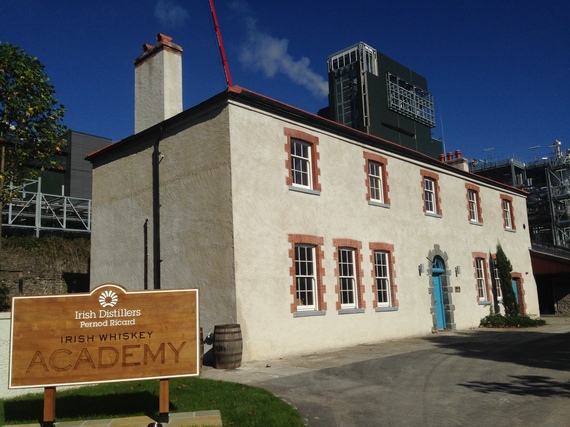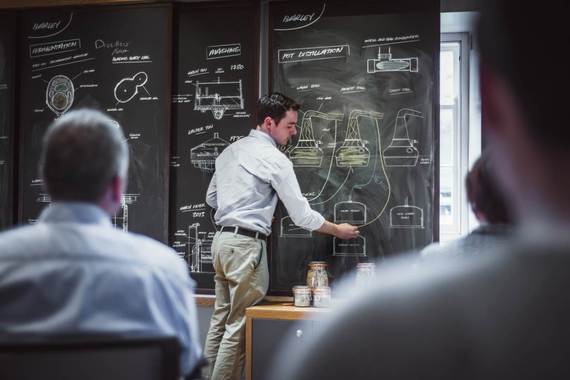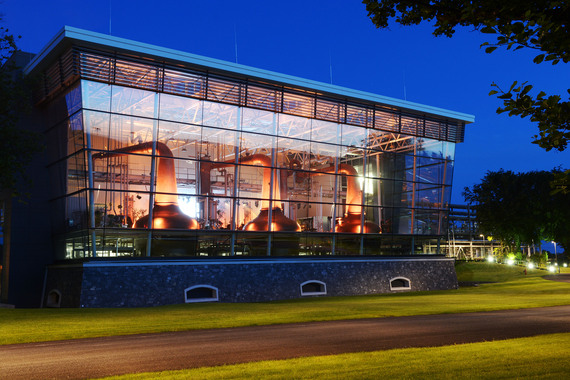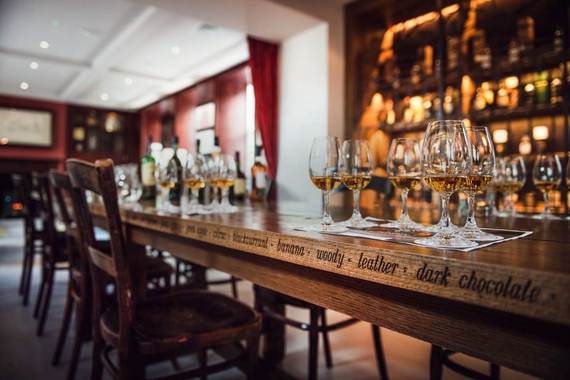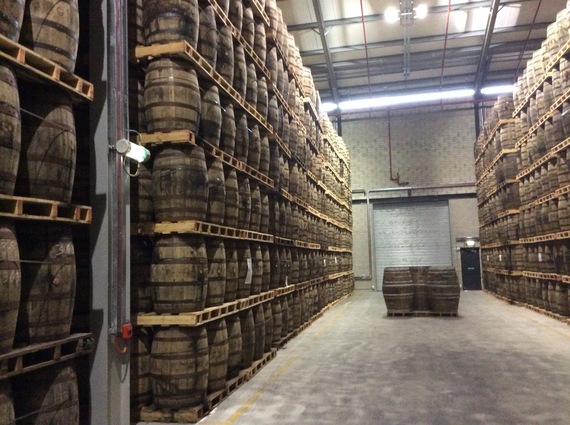The Irish Whiskey Academy at the Midleton Distillery Complex
Two truisms have long been at the foundation of the marketing of alcoholic spirits. The first was that each new generation would insist on drinking something different than its parents. After all, they dress differently, speak differently, listen to different music, so it was inevitable that they would drink differently too. The result was a predictable generational cycle in the appeal of each category of spirits. What was old and faded would become new and fresh just like today's hot brands are destined to skip a generation.
The second truism was that what you drank said more about how you perceived yourself than what you liked. How else can you explain the dominating market reach of Jägermeister, an herbal liqueur that virtually no one admits to liking but whose consumption worldwide of 92 million bottles set a new record in 2013? Sales in 2014 were down slightly. It was an obscure German liqueur, until Sydney Frank's brilliant marketing turned into a mandatory exercise in Friday night's, Jäger Raves, shooter extravaganzas.
Beverage companies have long embraced "lifestyle marketing", associating their brands with popular sports and social events, making sure that celebrities publically consumed their libations and that their liquor got prominent placement in popular films. All of the beverage companies now have specific departments geared to "influencer marketing", identifying and catering to trendsetters that can promote their brands. Indeed, you can make a good case that it was beverage companies, both alcoholic and non-alcoholic, who, along with cigarette companies, popularized the concept of lifestyle marketing.
Today we can add one more emerging truism, that what you know about your booze is just as fashionable as what you drink. The trend began with the emergence of visitor centers at distillers. This phenomenon was virtually nonexistent before the 1980s but is now de rigueur at trendy distilleries as is the mandatory online presence complete with the distillery's history, tasting notes and profiles of its staff and its spirits.
Indeed, distillers and blenders have become the newest celebrities of the whisky world. With well-known blenders and distillers receiving rock star like adulation at popular consumer shows and events. It's all very strange to long time industry participants. A distillery after all is little more than a cross between a chemical plant and a refinery, not exactly the sort of facility that you would expect to host a visitor center complete with gift shop and restaurant.
Now beverage companies are raising the bar once again, offering "schools" for their most devoted customers. Educating your customers is not new to beverage companies, but such "education" was typically limited to members of the trade, the staff of trendy bars or upscale restaurants. Now those same electives are being made available to consumers as well.
Far and away, the best offering is the Irish Whiskey Academy that is housed at Irish Distillers Midleton Distillation complex just outside of Cork Ireland. The facility, houses Ireland's largest grain and pot still distilleries and is the oldest operating distillery in Ireland after the famed Bushmills distillery in County Antrim, Northern Ireland. The Midleton Distillery is where Jameson, Ireland's bestselling whisky, the world's third most popular, is produced.
Instructor at the Irish Whiskey Academy explaining the intricacies of triple distillation
The Academy opened in February of 2013 and describes itself as "the dedicated whiskey institute of Irish Distillers Pernod Ricard", hosting courses that focus on the production and heritage of Irish whiskey produced at Midleton." It offers half-day "Afternoon at the Academy", single day, "Discoverer" and two days "Enthusiast" course options that promise to teach budding whiskey enthusiasts "how whiskey is crafted from grain to glass".
The one-day course offers a detailed examination of how Irish whiskey is produced while the half day version is a condensed version of the full day option. The two-day version includes the opportunity to try your hand at blending whiskey as well as a visit to the distillery's onsite cooperage to watch barrels being repaired. Students in the single day and two-day course also receive a 500ml bottle of Midleton Single Pot Still Whiskey that has been specially crafted for attendees of the Whiskey School. Only 500 bottles of each special blend are made at a time, making it one of the rarest Irish whiskies in the world.
The course outline is an in-depth exploration of Irish whiskey production, exploring both how Irish whiskey is made and those aspects of its production unique to Irish whiskey making. The class starts by examining the various sources of water used by the distillery, from the Dungourney River which flows through the grounds of the distillery to a natural underground spring that supplies water at a constant 52 degrees Fahrenheit/11 degrees centigrade to cool the condensers to the tap water, which, once purified through a reverse osmosis treatment, is used for reducing the whiskey to bottling strength at the Fox and Geese bottling plant in Dublin.
The water from the Dungiourney River is naturally rich in calcium and magnesium which the distillery believes facilitate fermentation. In Scotland, soft water, i.e., low in calcium and other minerals is preferred by most distilleries, that's why so many distilleries are located in Speyside; although both Highland Park and Glenmorangie, two Highland distillers, have historically used "hard", calcium rich, water.
The class proceeds to examine how both malted and unmalted barley, the use of the latter a unique feature of Irish whiskey production, are used in whiskey making. The use of unmalted barley by Irish distillers was a response to the imposition of the British government's Malt tax in 1692. In the remote Scottish Highlands, distillers, safe from the prying eyes of the tax man, ignored the tax and continued to use malted barley.
In Ireland, far more accessible to London's tax collectors, distillers reduced the amount of malted barley they used to reduce the tax and relied on a larger proportion of unmalted, or green, barley. The use of unmalted barley gives Irish whiskey a creamy, dense mouth coating texture, one of the hallmark characteristics of Ireland's whiskey.
Pot stills at the Midleton distillery complex
Brewing and fermentation come next, including a visit to the mash house which hosts two, 20,000-liter size mash tuns and two mash filters with the same capacity. The distillery has a total of 14 washbacks (fermenters) for pot distillation and an additional twenty-two for the grain whisky side. Each washback has a capacity of between 200,000 and 215,000 liters.
The malted and unmalted barley, referred to as the "mash bill," are ground by a hammer mill into grist and put in the mash tuns where they are subjected to three successive treatments with hot water to extract the soluble sugar from the barley. At Midleton, the grist is ground to a particularly fine 2.5 mills, about 63 microns, roughly comparable to a finely ground flour; this is much finer than the typical practice, 5 to 10 mills, in Scotland.
A finer grind maximizes the extraction of sugar from the grist. The resulting sugary liquid, called wort, is then filtered through a "plate and frame type" mash filter using compression rather than gravity flow before it is moved to the fermenters where the yeast will do their magic. Midelton's solid-free wort is crystal clear before it is fermented, a practice that it shares with many Japanese whiskey makers.
Scottish worts, on the other hand, vary from cloudy, i.e., lots of suspended flour (fines), to clear. The cloudier the wort the more likely it is to produce cereal and nutty notes in the resulting whiskey. Fermentation lasts about 60 hours, a relatively fast ferment in the whiskey industry. If you are determined to become an expert on Irish whiskey, this is the kind of detail that the Irish Whiskey Academy will teach you.
From fermentation the liquid, now called wash, is moved to the stills. The wash is a beer like liquid with an alcohol by volume (ABV) of around 10%. The classic Irish whiskey undergoes a triple distillation unlike the typical Scotch whiskey that undergoes a twostep or double distillation.
In the first distillation a spirit, now called low wine, at 25% to 45% ABV is collected. This is subject to a second distillation in the feint still during which undesirable alcohols and aromatic elements called congeners are removed. The second distillation produces a spirit with an ABV of 70% to 75%. This spirit is then subject to third and final distillation to produce the "new make spirit"
The portion of the distillate which is collected for the second distillation is called the strong feints. The portion that is eliminated prior to starting the collection of the strong feints is called the heads and the portion eliminated after stopping the collection of the strong feints is called the tails. Collectively, the heads and tails are called feints. These are added to the next batch of low wines and are redistilled.
Tasting room and whiskey bar at the Irish Whiskey Academy
The strong feints are sent to the spirit still for the third and final distillation. Here again the heads and tails are removed and the center cut, now called new make spirit, is moved to the new make receiver. The final spirit collected in the center cut averages around 84% ABV. The ABV strength where the distiller begins and ends his collection of the center cut are called the cut points. The higher the initial and final cut points, the lighter the whiskey that results.
The lighter character of Irish whiskey is the result of both the fact that it is triple distilled as well as the fact that Irish distillers generally use higher cut points then their Scottish counterparts. Whiskey produced exclusively from pot still distillation is called "pot still" whiskey. It can be bottled either as "pot still" or blended with grain alcohol to produce a blended whiskey.
Midleton also produces grain whisky, one of the few distillery complexes in the world where both column still and pot still whiskies are produced. The production process for grain whisky is somewhat different than for pot still whiskey, although the basic steps are the same. The main difference is that any grain can be used. In Midleton's case this is primarily corn with a little bit of malted barley, and the distillation utilizes a continuous still that can produce alcohol at a 95% ABV rating. Grain whiskey undergoes a similar maturation process as pot still whiskey and is blended with pot still whiskies to produce blended whiskies like Jameson or Paddy.
At Midleton, a range of different pot still and blended whiskies are produced; from Ireland's best-selling whisky, Jameson, to such iconic brands as Red Breast, Green Spot, Yellow Spot, Powers, Paddy and the distillery's own namesake Midleton. All of the different whiskies produced at Midleton are produced exactly the same way up to the distillation phase.
Each distillation can be altered depending on the type of spirit the distiller wants to create. For example, according to David McCabe, the chief instructor at the Academy, "when making traditional pot still whiskey all of the alcohol is effectively distilled off giving low wines of approximately 22% ABV. For other styles a stronger low wine is produced, in some cases closer to 45% ABV."
It is primarily in the charge (fill) levels of the stills, the various combinations of low wines, weak feints and pot feints that are redistilled, the choice of cut points for collecting the distillate at each phase of the distillation and in their subsequent maturation and blending that the distinctiveness of each particular whisky brand is created.
Following distillation, the new make spirit is moved into oak barrels for maturation. The bulk of the barrels used at Midleton are American ex-bourbon barrels made from American white oak. The distillery purchases around 150,000 ex-Bourbon barrels each year. These are shipped assembled, known as "standing casks" to the distillery. The distillery also purchases about 5,000 sherry casks and an indeterminate number of ex-port casks that are also used in maturation.
One of 50 warehouses for maturing whiskey at the Midleton distillery.
At Midleton there are more than 1.3 million barrels of Jameson whisky undergoing maturation. The roughly 2% of alcohol which is lost to evaporation every year, what distillers call the angel's share, amounts to the equivalent of 20,000 bottles of Jameson whisky every day. I wonder what the angels do with all that whiskey?
One of the high points of attending the Irish Whiskey Academy is an opportunity to sample some of the whiskies produced by the distillery. Whiskey tastings take two forms. The first is a formal tasting held at the academy itself. The most exciting part of the tasting experience however comes when students have an opportunity to visit one of the warehouses used to mature the various components that are blended to create the different Jameson expressions and taste straight from the barrel samples of maturing whisky.
Having recently spent a day at the Academy, I can attest both to the professionalism of its staff and to their no holds barred introduction to the intricacies of modern Irish whiskey distillation. The program offers a behind the scenes look at a modern working distillery that most whiskey enthusiasts can never experience for themselves not to mention that students leave with a thorough understanding of how Irish whiskey is made and more importantly how it differs from its Scottish and North American cousins.
Besides, to the hard core whiskey fan the opportunity to wander through a warehouse stacked to the ceiling with aging barrels of whiskey isn't one to be missed nor is the opportunity to taste straight from the barrel samples. In my case, the high point was tasting a 25-year-old whiskey that had been maturing its entire life in a former port wine hogshead barrel.
Since that particular barrel was destined to be used in a blend for the Jameson 18-year-old Limited Reserve, the opportunity to taste it unblended straight from the barrel was a once in a lifetime chance. With more than 1.3 million barrels of Jameson whiskey aging at the Midleton Distillery complex, and more being added every day, there are plenty of reasons for a second visit. Here's hoping for another invite.
For more information on the Irish Whiskey Academy see http://www.irishwhiskeyacademy.com/
